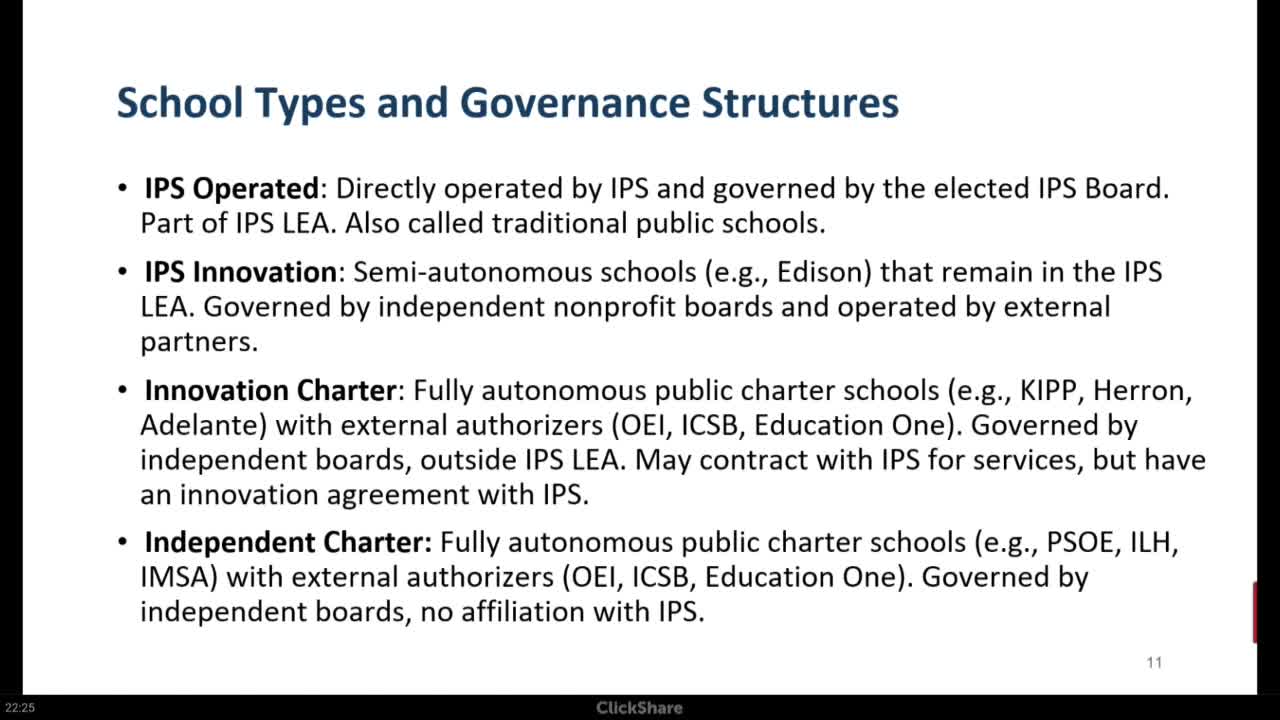Indianapolis education leaders address funding complexities for charter and public schools
June 25, 2025 | Indianapolis City, Marion County, Indiana
This article was created by AI summarizing key points discussed. AI makes mistakes, so for full details and context, please refer to the video of the full meeting. Please report any errors so we can fix them. Report an error »

The Indianapolis Local Education Alliance convened on June 25, 2025, to discuss the current landscape of education in the city, focusing on the diverse ecosystem of public charter and innovation schools. The meeting highlighted the significant role these institutions play in serving nearly 22,000 students across 55 independent charter and innovation charter schools, alongside 47 direct-run Indianapolis Public Schools (IPS) that cater to about 20,000 students.
Key discussions centered on the operational independence of charter schools, which, while part of the IPS innovation network, are managed by independent operators. The Office of Education Innovation (OEI) authorizes 18 of these schools, with the Indiana Charter School Board overseeing an additional seven. Notable examples include KIPP Indy Public Schools and Purdue Polytechnic High Schools, which operate without formal ties to IPS.
The meeting also addressed the complexities of funding for public education in Indiana, which relies on a combination of federal, state, and local sources. State funding, primarily derived from income and sales taxes, constitutes a significant portion of the education budget, while local property taxes contribute to operational costs. However, challenges such as property tax rate caps and increased deductions threaten the sustainability of funding for essential services like transportation and facility maintenance.
A detailed analysis of funding sources revealed that for IPS, state tuition support accounts for approximately 43% of revenue, with local taxes contributing 35%. In contrast, a comparable public charter school receives nearly 57% of its funding from state tuition support. The meeting underscored the importance of collaboration among schools to maximize the use of public dollars and improve educational outcomes for all students.
As the meeting concluded, participants acknowledged the need for ongoing discussions and deeper dives into the data presented, emphasizing the alliance's commitment to finding efficiencies and enhancing the educational landscape in Indianapolis. The next steps will involve further exploration of funding mechanisms and collaborative strategies to address the challenges faced by the city's schools.
Key discussions centered on the operational independence of charter schools, which, while part of the IPS innovation network, are managed by independent operators. The Office of Education Innovation (OEI) authorizes 18 of these schools, with the Indiana Charter School Board overseeing an additional seven. Notable examples include KIPP Indy Public Schools and Purdue Polytechnic High Schools, which operate without formal ties to IPS.
The meeting also addressed the complexities of funding for public education in Indiana, which relies on a combination of federal, state, and local sources. State funding, primarily derived from income and sales taxes, constitutes a significant portion of the education budget, while local property taxes contribute to operational costs. However, challenges such as property tax rate caps and increased deductions threaten the sustainability of funding for essential services like transportation and facility maintenance.
A detailed analysis of funding sources revealed that for IPS, state tuition support accounts for approximately 43% of revenue, with local taxes contributing 35%. In contrast, a comparable public charter school receives nearly 57% of its funding from state tuition support. The meeting underscored the importance of collaboration among schools to maximize the use of public dollars and improve educational outcomes for all students.
As the meeting concluded, participants acknowledged the need for ongoing discussions and deeper dives into the data presented, emphasizing the alliance's commitment to finding efficiencies and enhancing the educational landscape in Indianapolis. The next steps will involve further exploration of funding mechanisms and collaborative strategies to address the challenges faced by the city's schools.
View full meeting
This article is based on a recent meeting—watch the full video and explore the complete transcript for deeper insights into the discussion.
View full meeting
